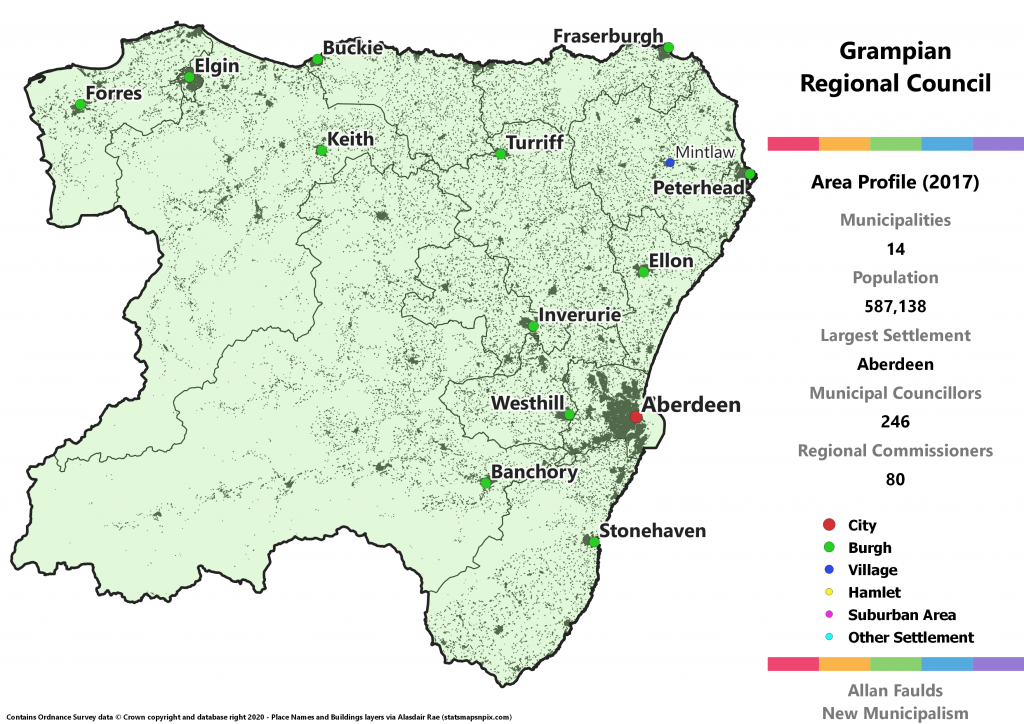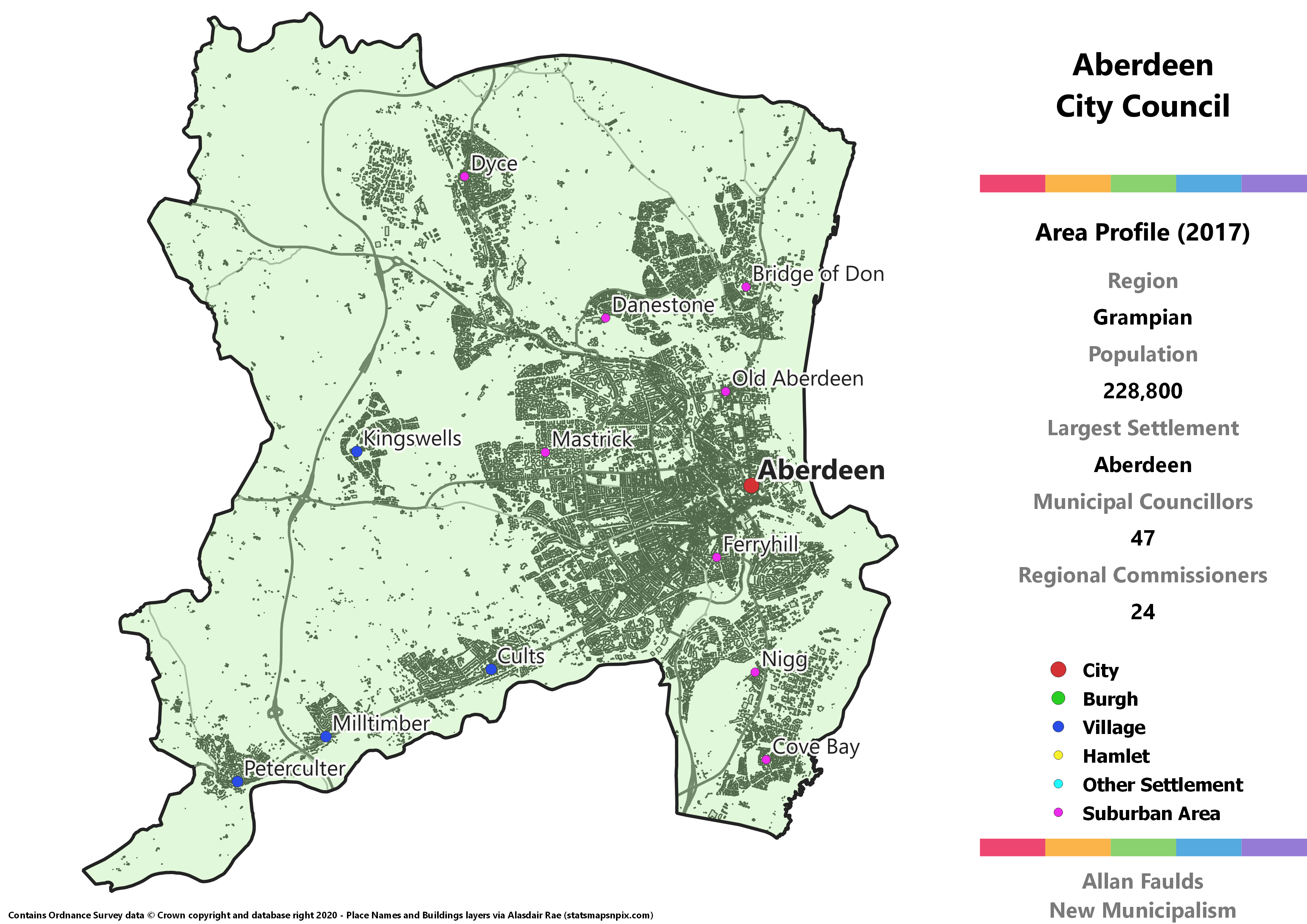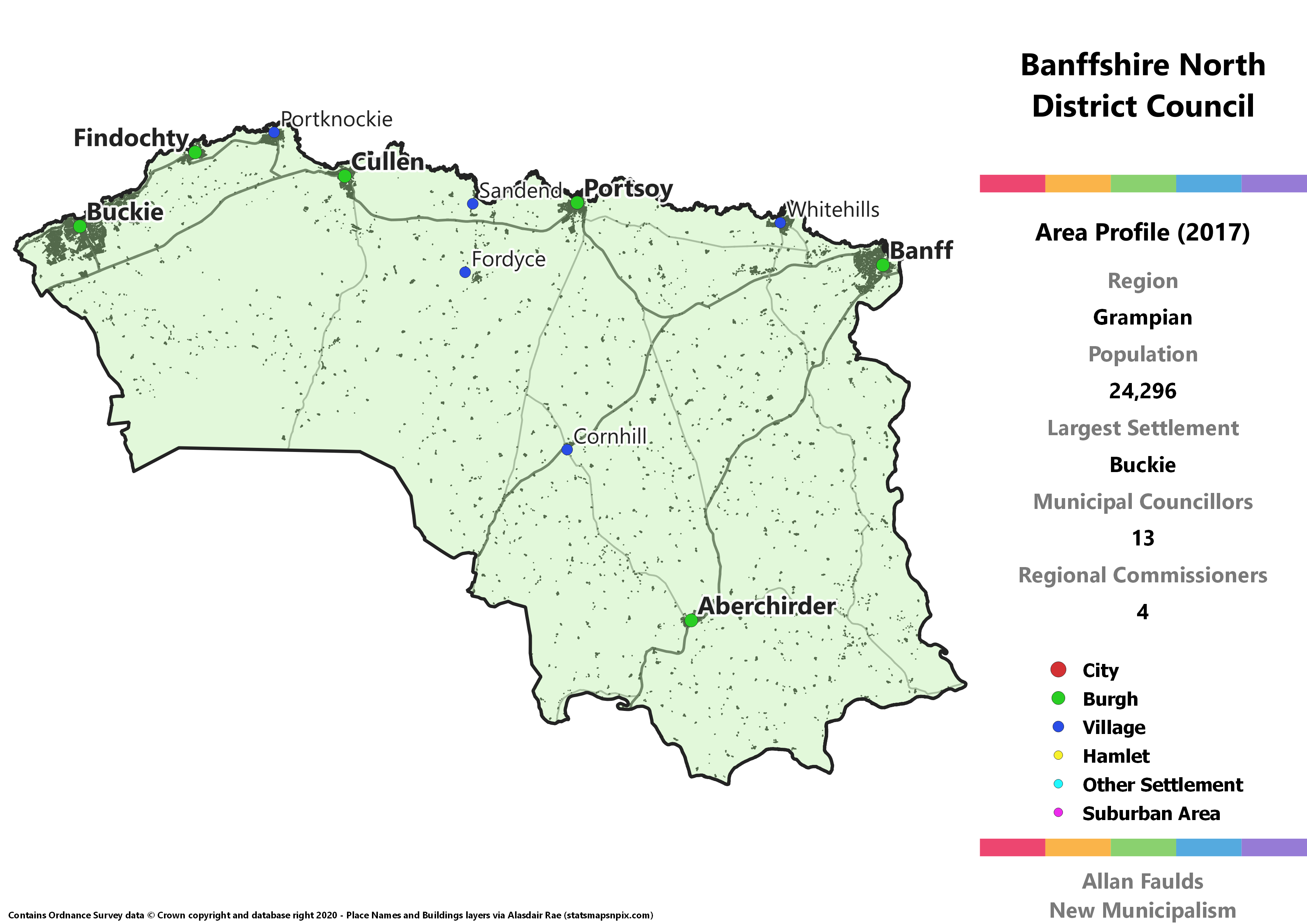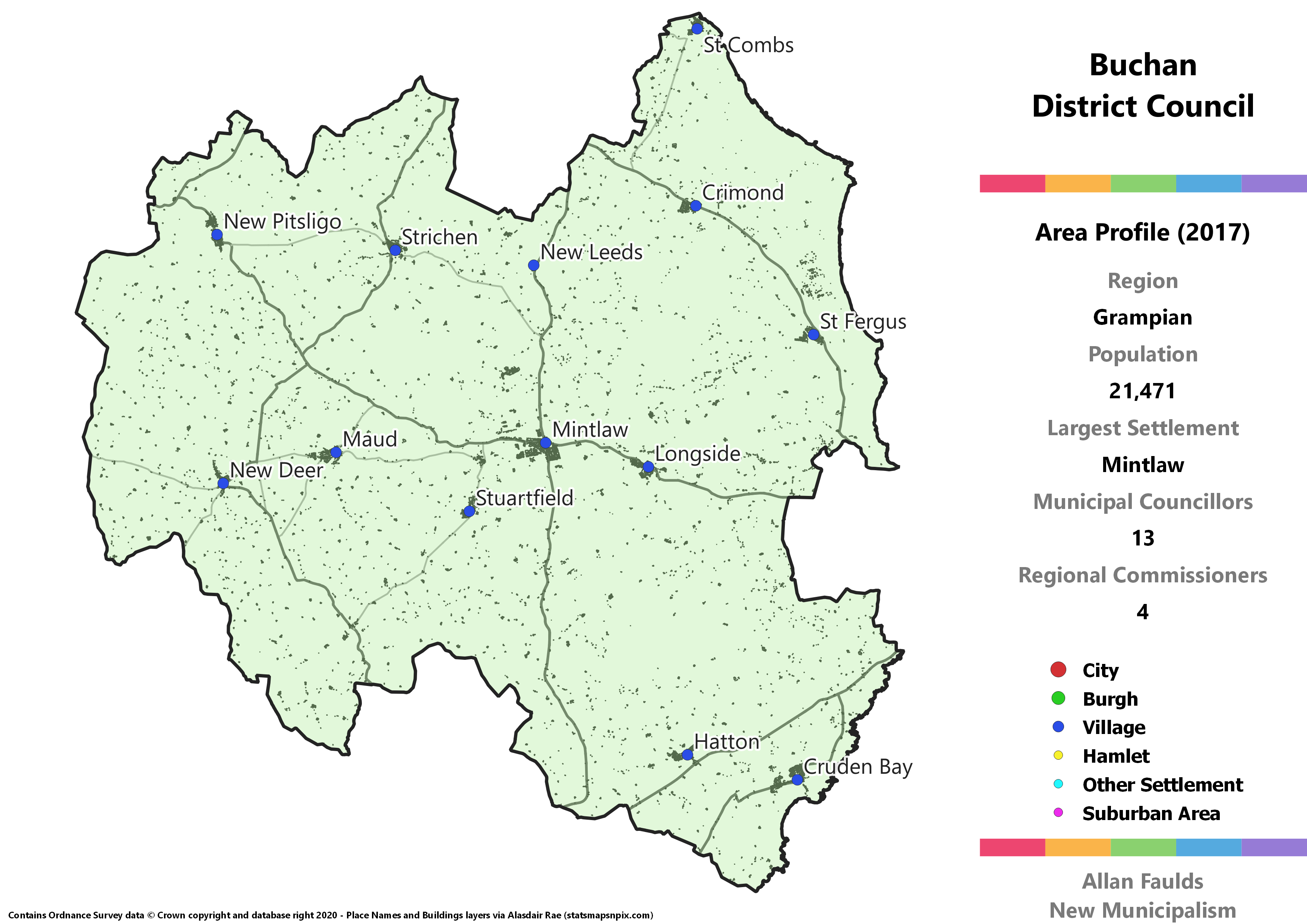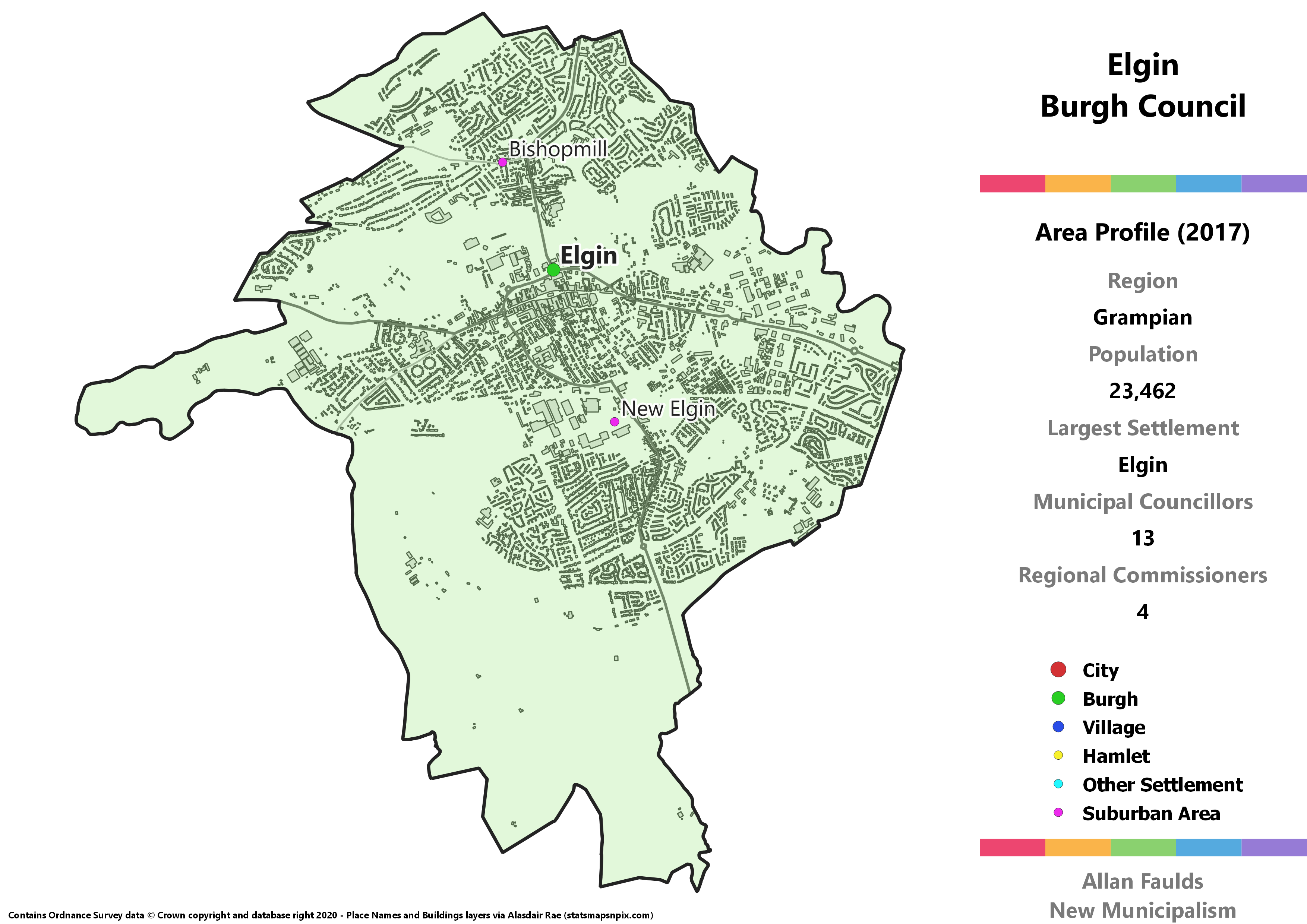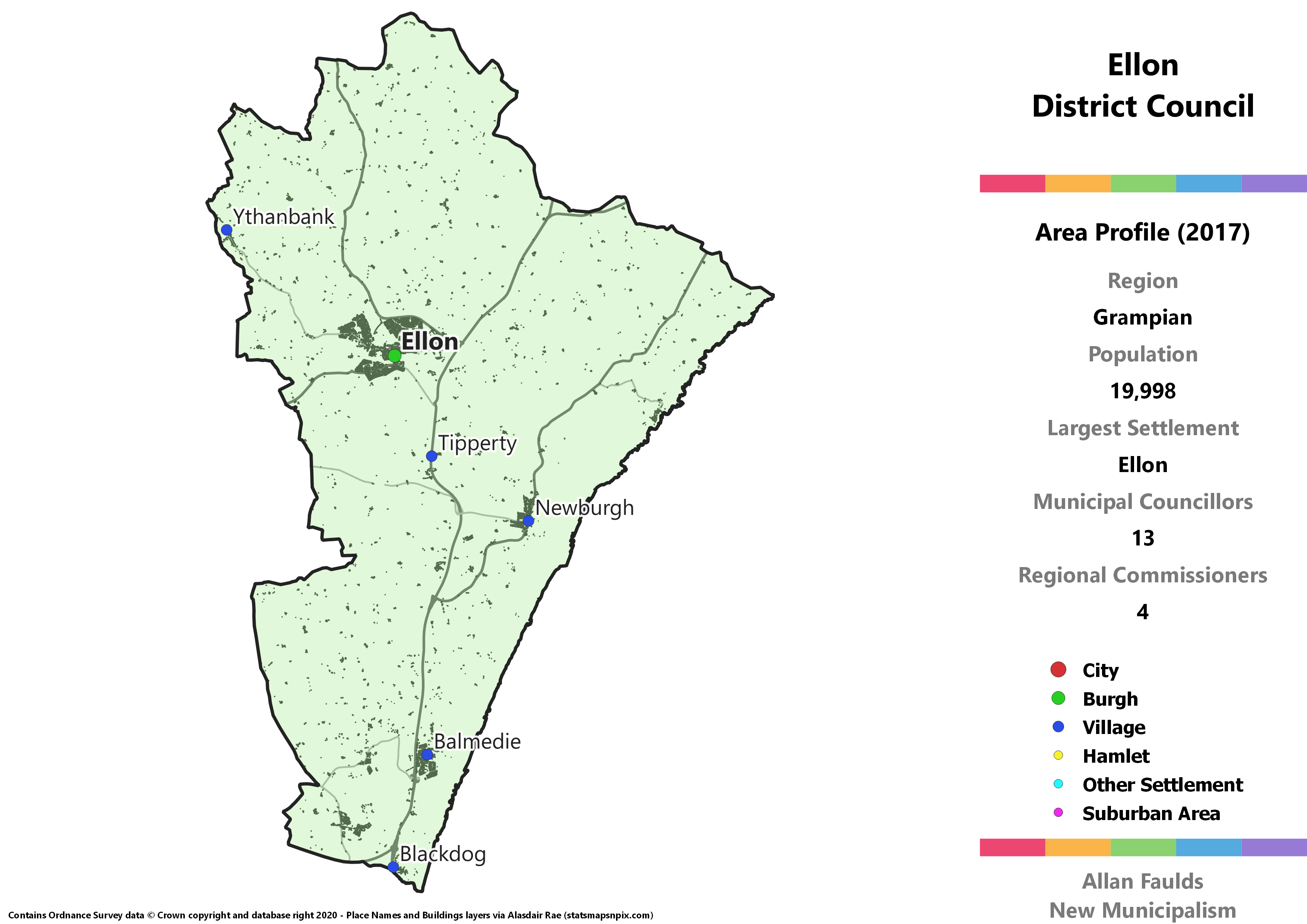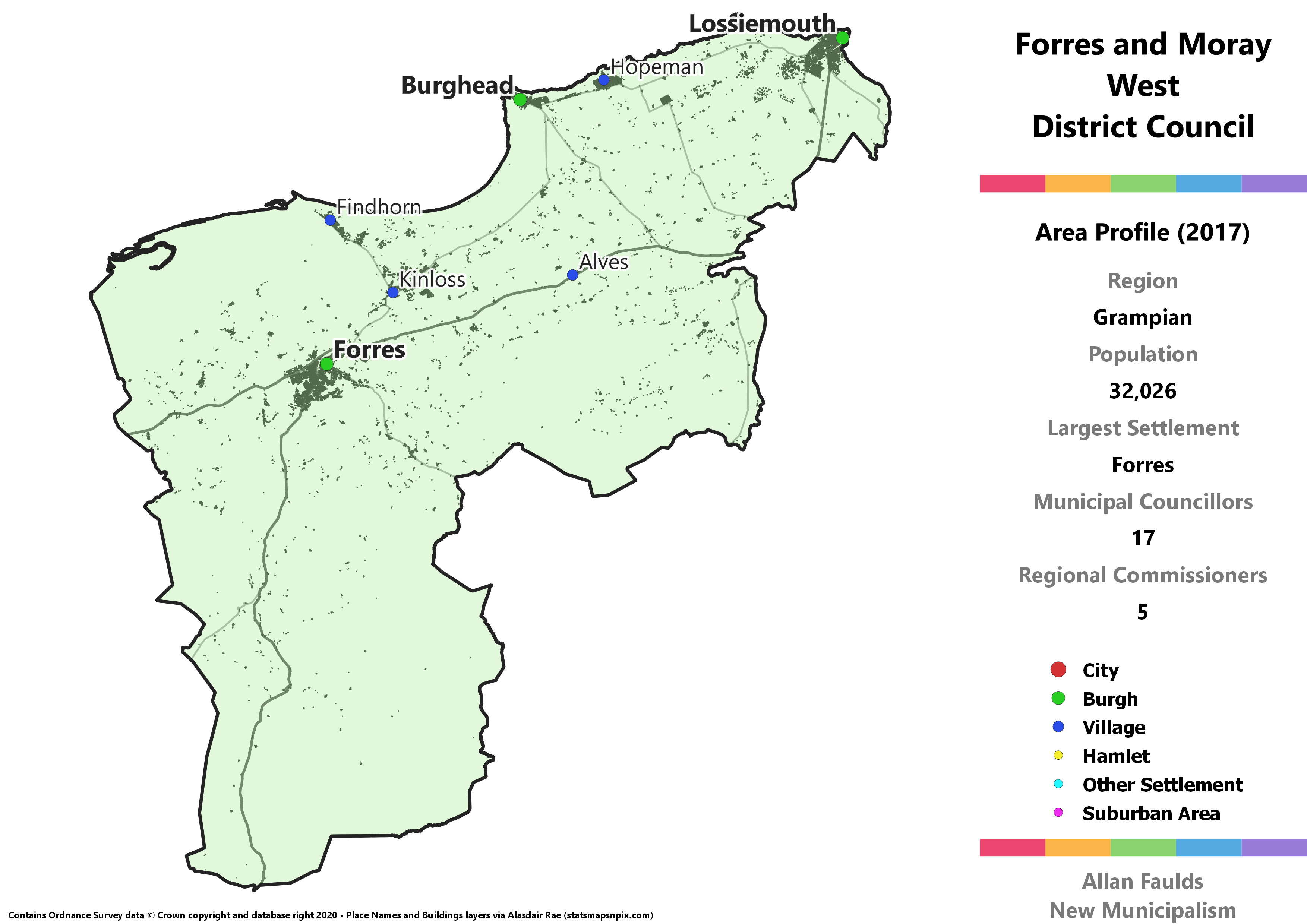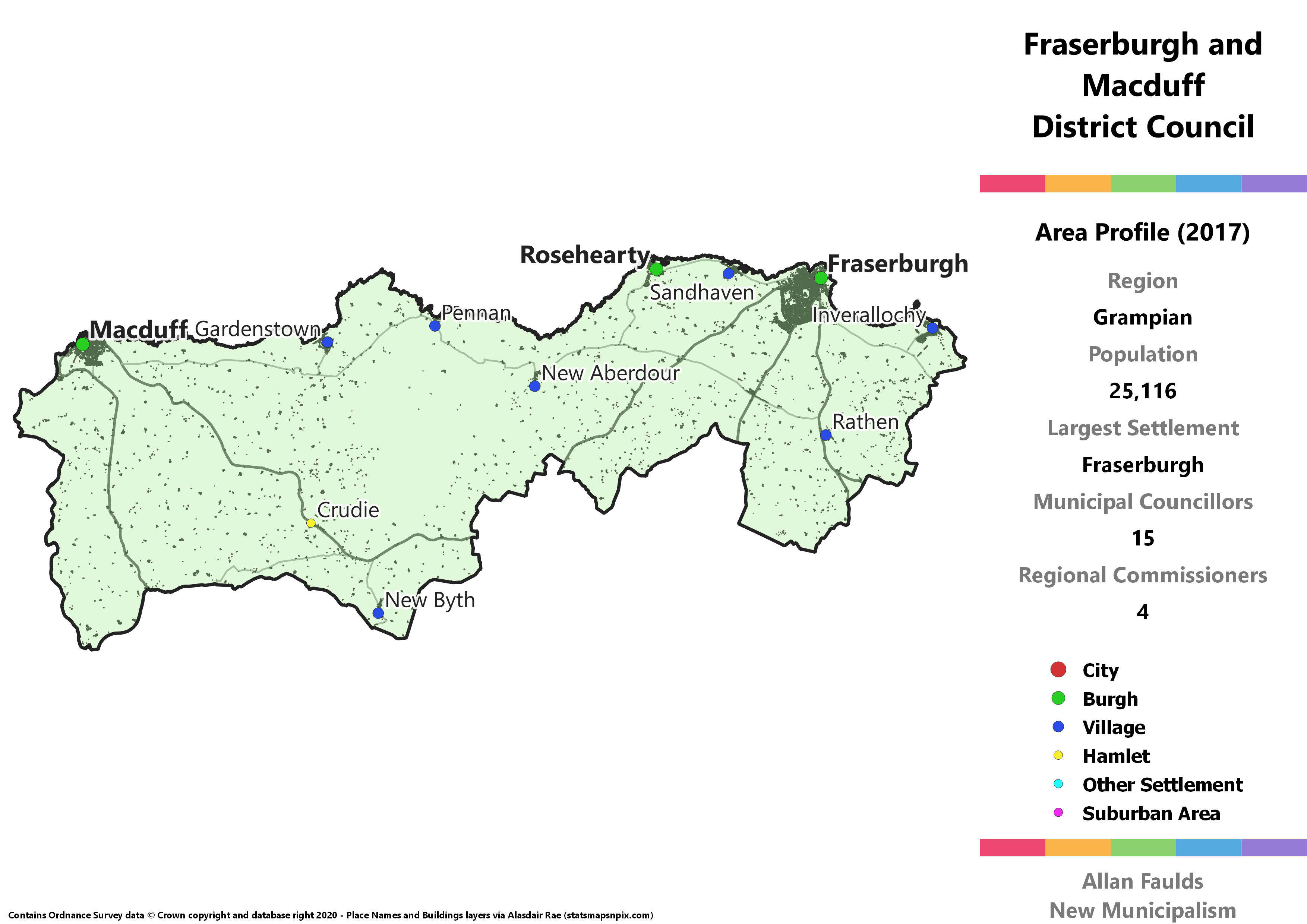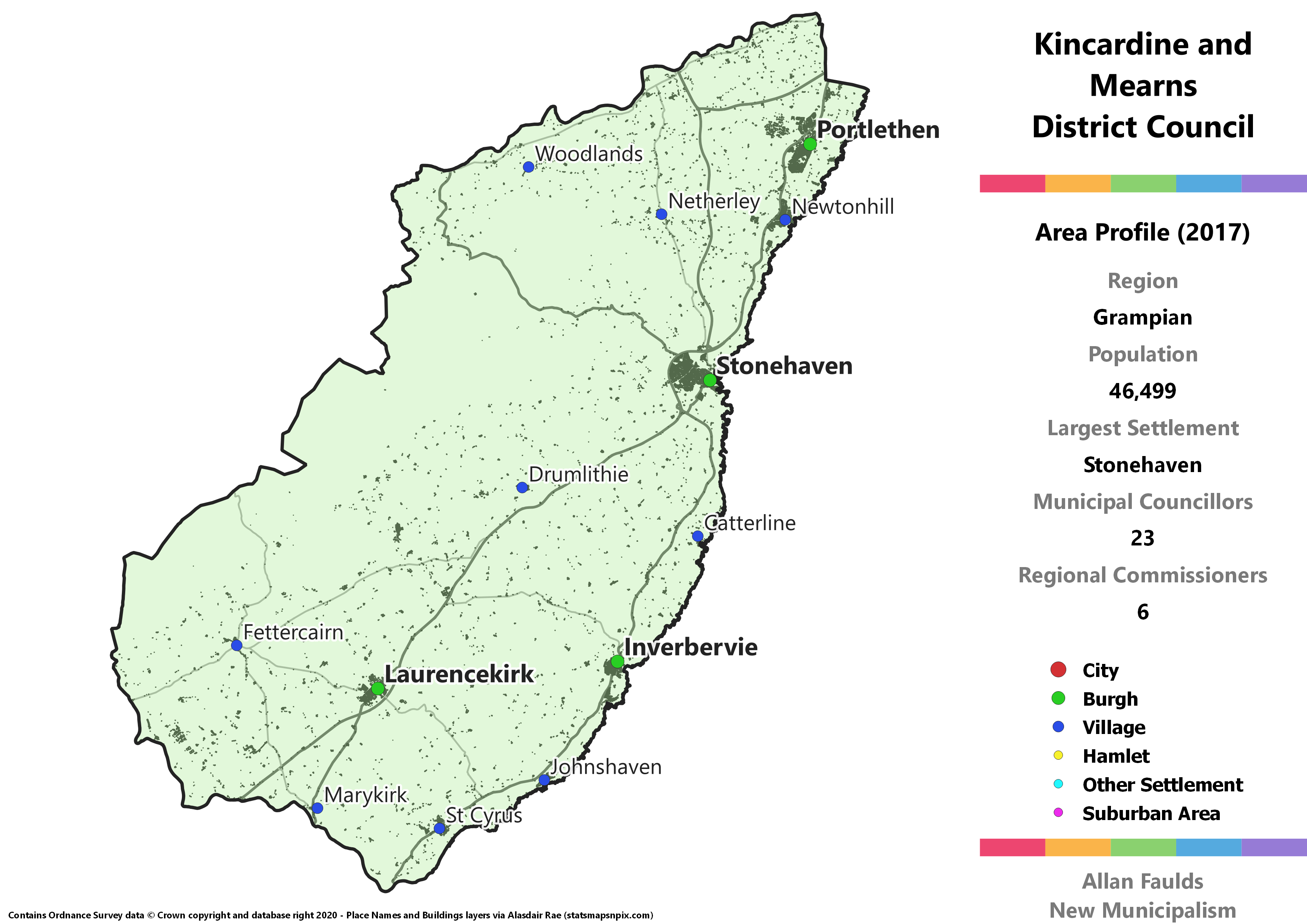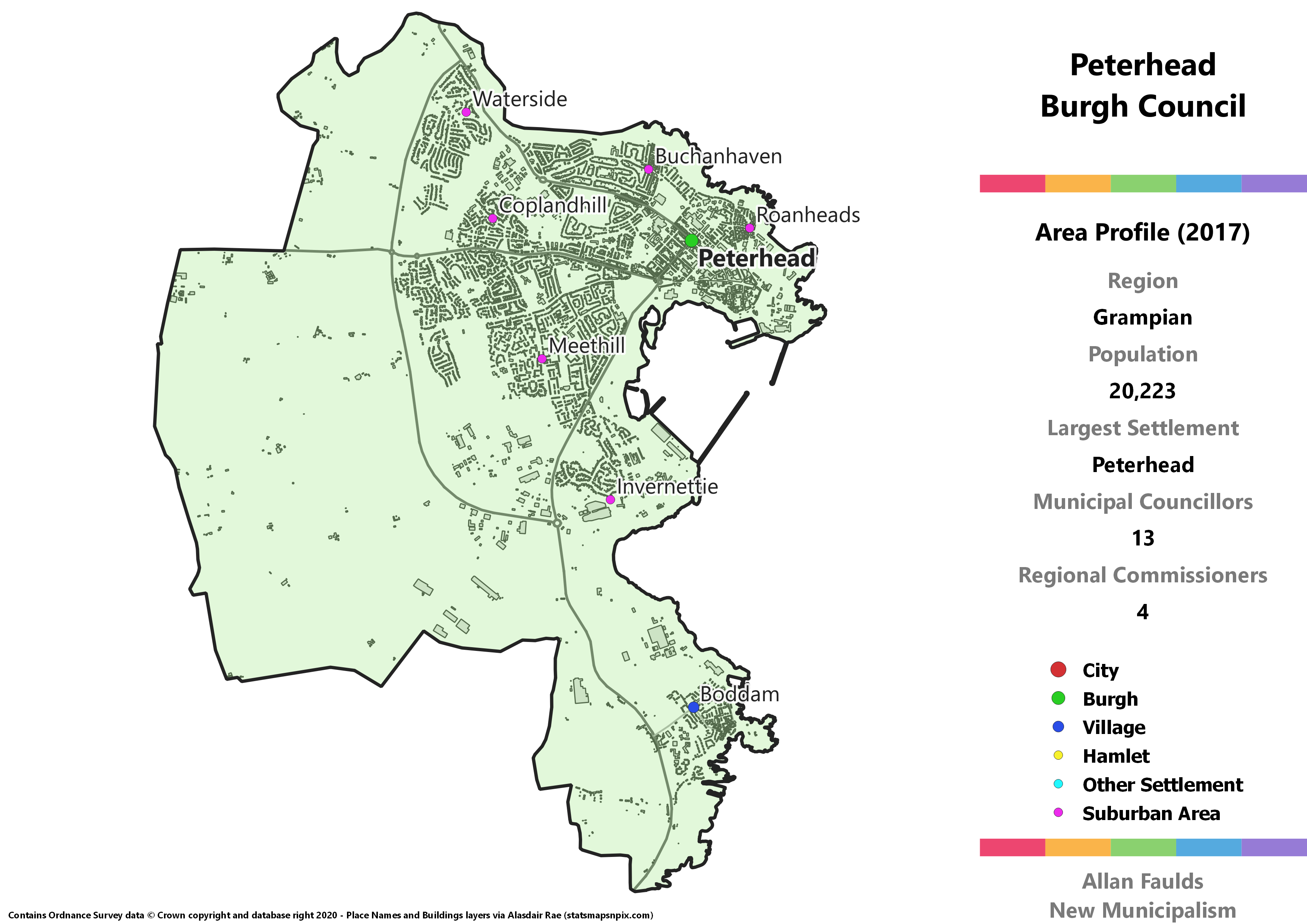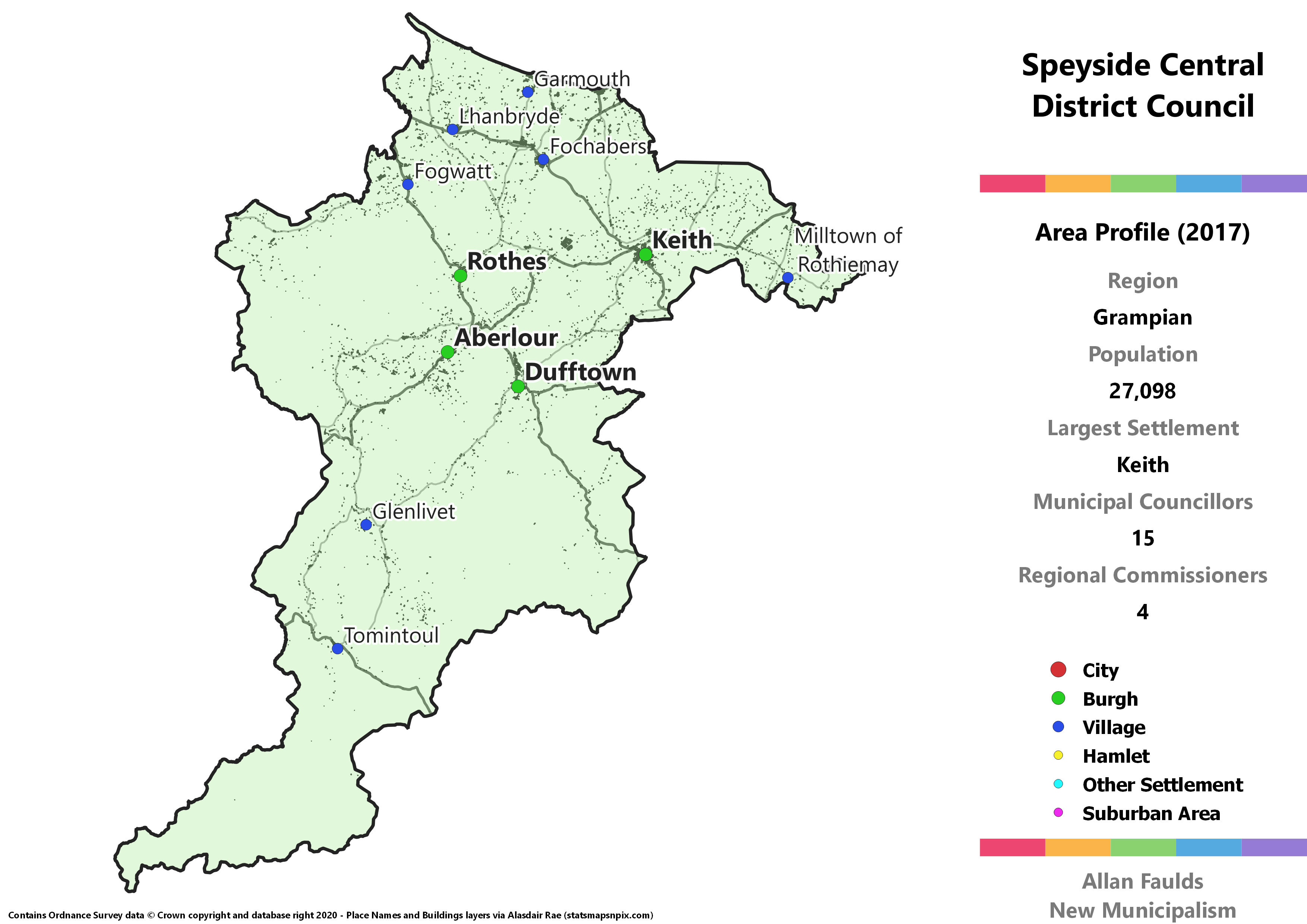Grampian Region Overview
Key Statistics
Municipalities: 14
Population: 587,138
Largest Settlement: Aberdeen
Municipal Councillors: 246
Regional Commissioners: 80
Region Description
At the regional level at least, Grampian is a simple re-creation of the same region from the 1973 Act. It covers the entirety of that north eastern corner of Scotland, centred on the third largest city in the country, Aberdeen. At present this massive area is divided into just three local councils – Aberdeen City, Aberdeenshire and Moray. In the previous regional setup, Aberdeenshire was split into three districts, all of which are much larger than what I’m aiming for in this project. Historically speaking, this area was home to two further counties, Banffshire and Kincardineshire, which have since disappeared from the local government map.
Whilst the two largest cities in the country have been given Unitary Authority status in this project, Aberdeen is absorbed into this wider region. Whilst I’d expect Aberdeen to exert a substantial influence over Grampian as a whole, it isn’t utterly dominant. The population of the city is just under 40% of the region, and its share of seats on the Regional Council is only 30% due to the weighting in favour of smaller municipalities.
One point of potential awkwardness is what is currently the Moray Council area. Although it was included in the previous Grampian too, there’s perhaps a sense that at least the western portion of it looks more to Inverness than to Aberdeen as a regional centre. I’ve opted to keep the whole area in, but it’s perhaps one to think about, especially bearing in mind most of the area of what is now Moray is actually the inland portion of Banffshire. It might – might! – be just about doable in terms of local identity to split between Grampian and Highland regions along those lines.
A combination of the region’s largely rural character plus the Lib Dem collapse has seen the Conservatives become the strongest party in the region. Covering some of the SNP’s historic strongholds however, they aren’t a million miles behind. Although the Lib Dems are much depleted, they do still come third, making this their second strongest region. Labour are a more distant fourth these days, and the 2017 results would suggest high diversity with the presence of a handful of Greens as well.
Aberdeen City
Area Profile (2017)
Population: 228,800
Largest Settlement: Aberdeen
Municipal Councillors: 47
Regional Commissioners: 24
Municipality Description
Aberdeen already has its own City Council, and there’s no reason for that to change – only what functions it performs. As a major city, it was separated from its Shire well over a century ago when it became a “City and County”, effectively what we now call a Unitary Authority. When it was brought into the Grampian region under the 1973 Act, it expanded to take in areas the city had grown into including the Bridge of Don, Dyce, Cove Bay and Cults. It also pulled in some not-quite connected villages in Kingswells, Milltimber and Peterculter.
There are very minor boundary changes compared to the existing Council, expanding slightly in the north to take in the newly-completed “Aberdeen Western Peripheral Route” as a sensible boundary, and losing a spur of countryside in the south beyond Peterculter. The effect of these changes on the city’s population is negligible.
In political terms, although this is basically the same as the existing Aberdeen City, the Council looks very slightly different just by applying the same election rules to it as the rest of the project. Aside from an extra 2 seats overall, the distribution of seats between parties is more reflective of vote share, and as a major city all five Holyrood parties end up represented. It does end up short the two Independent councillors that were elected though, as the list system is less friendly to them than STV. In a region that otherwise leans Conservative, it’ll be no surprise the SNP were the leaders in a big city.
Banffshire North District
Area Profile (2017)
Population: 24,296
Largest Settlement: Buckie
Municipal Councillors: 13
Regional Commissioners: 4
Municipality Description
Just because of the way they came about, a lot of Scotland’s traditional counties ended up quite oddly shaped. Banffshire was by no means the worst (no one dare mention Cromartyshire to me), but the coastal strip with the elongated, slanted spike into the Cairngorms was definitely peculiar. Banffshire North covers most of the coastal portion of that old county, stretching from the current largest town of Buckie to the historic county town of Banff itself.
The north east coast of Scotland was absolutely wild for small Burghs back in the day, by the way. This small district contains a whopping 7 of them – for whatever reason, Portnockie isn’t counted as a “Town” in the dataset I was using to drive these maps.
Buchan District
Area Profile (2017)
Population: 21,471
Largest Settlement: Mintlaw
Municipal Councillors: 13
Regional Commissioners: 4
Municipality Description
Buchan was formerly one of the three large “provinces” that made up what is now Aberdeenshire. In modern times it’s considered to be a smaller area at the northeastern tip of the country. This District covers most of that area and so gets it as a simple identifier, though you could argue the case for something like “Central Buchan” instead.
As Peterhead has been put into its own Burgh and Fraserburgh is also in a different municipality, this ends up as a distinctly dispersed district. There are a lot of small villages, of which Mintlaw is the largest, none of which necessarily make for an obvious administrative centre. An alternative arrangement might therefore be to split the Fraserburgh and Macduff District, allowing Fraserburgh to act as the centre for a larger Buchan District.
Elgin Burgh
Area Profile (2017)
Population: 23,462
Largest Settlement: Elgin
Municipal Councillors: 13
Regional Commissioners: 4
Municipality Description
By some reckonings, Elgin would be considered one of Scotland’s historic cities, having once had a major cathedral. Although Moray Council are trying very hard to keep that dream alive by including “City” in the ward names, I’m afraid it’s just a plain ol’ Burgh for me. That restores the status it held before the 1973 Act, with boundaries that only differ slightly to capture the full extent of the town.
Although the Conservatives still come out as the leading party based on 2017 results, they are tied with the SNP for seats. Throw in a solid trio of Labour councillors, very scarce elsewhere in the region, and in that sense at least Elgin lives up to its City aspirations.
Ellon District
Area Profile (2017)
Population: 19,998
Largest Settlement: Ellon
Municipal Councillors: 13
Regional Commissioners: 4
Municipality Description
Coming up just two residents short of the 20,000 target, I’m more than happy to let Ellon squeak through. The town itself, a former Burgh, contributes a shade over half of the population of this District, with much of the rest in villages like Balmedie, Newburgh and Ythanbank. It forms the eastern portion of the Formartine area, so if you were feeling Ellon was too specific there’s an alternative name to hand.
The only other thing to stand out about this one is that extrapolating 2017 results out gives it one of those rare-for-Grampian Labour councillors.
Formartine West
Area Profile (2017)
Population: 25,502
Largest Settlement: Turriff
Municipal Councillors: 15
Regional Commissioners: 4
Municipality Description
Yes, the fact Formartine West comes 2 residents over the 25,000 mark when its eastern counterpart is 2 short of 20,000 didn’t escape my notice. Very funny, Formartine. Anyway, this District covers a number of villages in an inland stretch of the current Aberdeenshire council. Two of these, Turriff and Oldmeldrum, were Burghs in the past, but together only account for about a third of the population, which is very well spread across a rural expanse.
Forres and Moray West District
Area Profile (2017)
Population: 32,026
Largest Settlement: Forres
Municipal Councillors: 17
Regional Commissioners: 5
Municipality Description
Forres and Moray West covers most of the current (and historic) Moray county to the north and West of Elgin. Forres had Burgh status before the 1973 Act, as did Lossiemouth and Burghead. I’ve got reason not to be 100% convinced by the placing of Lossiemouth here, but its location due north of Elgin makes it somewhat hard to place anywhere else either. Both it and Kinloss were known for their association with the RAF, before the Kinloss facility was re-purposed as barracks.
Politically speaking, this District is notable both for the strength of Independents (beating the SNP) and the presence of a Green on the council, based on 2017 results.
Fraserburgh and Macduff District
Area Profile (2017)
Population: 25,116
Largest Settlement: Fraserburgh
Municipal Councillors: 15
Regional Commissioners: 4
Municipality Description
This district covers the northern coastal portion of Buchan, most prominently the town of Fraserburgh, and the very eastern tip of historic Banffshire around Macduff and Gardenstown. Whereas much of the current Aberdeenshire area is relatively affluent, or at least not very deprived, there are quite a few deprived areas along this stretch of coast. Fraserburgh in particular has some of the highest levels of deprivation outside of the Central Belt. That’s a strong argument for a more local Council that can better respond to community issues and needs.
As noted in the Buchan section, it might be that this area might actually work best with the Banffshire portion going to Banffshire North, and the Buchan portion forming the administrative core of a larger Buchan District. For the moment however, I’ve stuck with my original proposal.
Inverurie and West Garioch District
Area Profile (2017)
Population: 26,015
Largest Settlement: Inverurie
Municipal Councillors: 15
Regional Commissioners: 4
Municipality Description
Garioch is an oddly shaped area anyway, but you can really tell this is where I’ve just stuck wards together. Inverurie and West Garioch is actually more like North Garioch, but I’ve stuck with existing nomenclature. The former Burgh of Inverurie is the major settlement here, making up over half the population of the District. That means it’s quite urbanised for an Aberdeenshire district, perhaps aided by proximity to Aberdeen itself.
Kincardine and Mearns District
Area Profile (2017)
Population: 46,499
Largest Settlement: Stonehaven
Municipal Councillors: 23
Regional Commissioners: 6
Municipality Description
Covering most of the area of the historic county of Kincardineshire, I did wonder if I could get two districts out of Kincardine and Mearns. But no, I could not. Stonehaven is too small for its own Burgh to be re-instated, and then there isn’t another sensible way to divide the area up. This district therefore extends to include Laurencekirk and Inverbervie, which were also Burghs before the 1973 Act, the much larger town of Portlethen, and large number of smaller rural villages.
Based on 2017 results, a defining quirk of this District would be a couple of Labour councillors. Few municipalities in Grampian would have any, so 2 for a District with a large rural component isn’t terrible for them.
Marr District
Area Profile (2017)
Population: 38,373
Largest Settlement: Banchory
Municipal Councillors: 19
Regional Commissioners: 5
Municipality Description
Drawing it’s name from one of the current Aberdeenshire Council’s Committee Areas, traditionally speaking Marr was a relatively thin strip that would have stretched from Braemar through Ballater and out to the sea. These days it also includes the area around Banchory, which was historically in Kincardineshire, plus Alford and Huntly to the north. This is a pretty big district in terms of both population and geographic extent, so I have considered that it could be split into a threshold-crossing southern “Marr and Banchory” District, and a northern below-threshold but gets a rural waiver “Huntly and Alford” District.
Grampian as a whole is quite favourable to the Conservatives, but that shows strongest in Marr. According to an extrapolation of 2017 results, the party would have a majority of seats on the Council.
Peterhead Burgh
Area Profile (2017)
Population: 20,223
Largest Settlement: Peterhead
Municipal Councillors: 13
Regional Commissioners: 4
Municipality Description
Peterhead is the only Burgh to be created from Aberdeenshire in this project, despite a surfeit of historic Burghs in the area. Pulling in the neighbouring village of Boddam just pulls it across the 20,000 threshold and therefore enables easy separation from the rest of Banff. As with other parts of coastal Buchan, Peterhead has substantially higher levels of deprivation than most other areas of Aberdeenshire. That means the issues faced by locals are likely to be different to those elsewhere, and helps justify a standalone municipality.
Speyside Central District
Area Profile (2017)
Population: 27,098
Largest Settlement: Keith
Municipal Councillors: 15
Regional Commissioners: 4
Municipality Description
Speyside Central covers most of the current Moray Council area, and is in effect the eastern portion of historic Moray plus the southern parts of Banffshire. This district lies on either side of the lower reaches of the Spey, well known as Whisky territory, and incorporates a cluster of old burghs – Keith, Rothes, (Charlestown of) Aberlour and Dufftown.
Based on 2017 results, this would be the only municipality in the region outside of Aberdeen to have an SNP lead. It’s extremely narrow and they’d be tied with the Conservatives in terms of seats, which would have handed an Independent the role of kingmaker in this hypothetical District.
Westhill and East Garioch District
Area Profile (2017)
Population: 28,259
Largest Settlement: Westhill
Municipal Councillors: 15
Regional Commissioners: 5
Municipality Description
Less funky-shaped than its western counterpart, Westhill and East Garioch consists largely of Aberdeen satellites. Westhill in particular is something of an informal Aberdeenshire New Town, having sprung up in the 60’s and grown to be the largest town in the area. It effectively displaced the former Burgh of Kintore as the main settlement in this area.
In the political sphere, the most notable aspect of this District is that it’d elect one of those scattered Green councillors. That’s indicative of the reality, as East Garioch is home to one of the party’s current crop of councillors.
